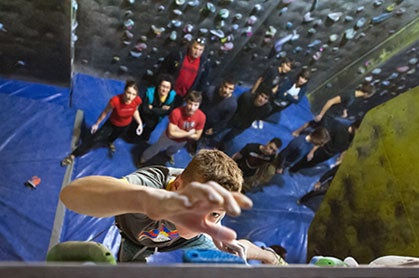Tuesday Night Bouldering

When a trail runner discovers the wonderful world of the bouldering gym
I’ve worked in an office full of climbers now for almost four years …
Photo by Luka Tambaca
I’ve worked in an office full of climbers now for almost four years, and, yet, I’ve somehow resisted climbing until this year when I finally caved and went to Rock and Ice magazine’s weekly indoor bouldering sesh, Tuesday Night Bouldering (TNB), and “pulled on some plastic.” I was quickly hooked.
I’ve been running for over a decade, and am a relative expert when it comes to the simple left-foot, right-foot sport. But climbing? Hell, I can’t understand the lingo. But being a beginner in a brand new sport is cool, especially when surrounded by experts that move up a wall like spiders.
Luckily, I’ve also bagged a few outdoor climbing days, and there’s something about “sending” a route that is akin to the feeling of crossing the finish line of a tough trail race. … Plus, with winter creeping into autumn, climbing might just be the perfect non-impact, off-day cross training (unless you crater) for trail runners. And, here’s why:
Climbing works your core.
While to a neophyte, climbing looks like pulling yourself up the wall with your arms, in fact, it requires moving from your core. “Your body is constantly tense to move your limbs up the wall to control body swing,” says Gentrye Houghton, climbing instructor and owner of Amarillo Rock Climbing House in Amarillo, Texas. This is especially important for runners who don’t practice a regular, well-rounded core routine.
Climbing develops mental focus.
Unlike running, when your mind is free to think of a million things or nothing at all, in climbing, your mind must be present, clear and focused on only the task at hand, or else, says Chris Parker, a climber in Carbondale, Colorado, “You’ll find yourself on the end of the rope or lying on the pad thinking, ‘What just happened?’”
When it comes to a boulder problem, for example, Parker continues, “You have to imagine yourself executing the moves of the climb and 100-percent of your focus must be on that execution.” The ability to zone in with a singular focus can be helpful to runners. When a race becomes difficult, for example, you need to employ mental power to block out the pain that’s telling you to slow down and back off the pace. Using mental focus, you can learn to effectively push mental and physical limits to become a stronger runner.
Climbing increases balance and body awareness.
“Climbing can be very delicate,” says Houghton. “You’re constantly using your body as a counterweight to balance yourself.” In short, you have to learn to trust foot placement, grip small holds and effectively use your body weight to maneuver up a wall. Says Jeff Jackson, editor of Rock and Ice magazine, “If your balance wavers for a microsecond, you’re falling.” Learning to focus on balance development will no doubt make you a stronger trail runner, especially when it comes to uneven, technical terrain.
Jackson continues, saying that more than just balance, “poise” is also crucial. “Height and its inevitable corollary, the perception of danger, can mentally rattle you and shut down your physical systems, effectively freezing you and bringing on a dangerous rush that flushes fatigue through your muscles,” says Jackson. “The mental disposition of balance in the midst of tension is also a key aspect of climbing and is something that feeds your life in all kinds of positive ways.”
How does this translate to the trail? Think about a particularly difficult run, when your muscles were fatigued and you found yourself stumbling over rocks and roots, losing form and slowing down. Utilizing balance and poise in moments like these will keep you from ending up at the finish line, bloody-kneed.
Climbing is fun and social.
And while this last point isn’t going to improve your running form, it does provide a bonus fun factor. If you have climber friends, you’ve probably heard them all talk about “hanging at the crag.” Indeed, climbing offers ample opportunity to socialize and just hang out. Says Alison Osius, a Rock and Ice editor and columns editor for Trail Runner, “In climbing, you really have dialogue: on the ground or at belays in roped climbing, and a lot of times in bouldering, except when you are hard at work on a problem. But you rest in between, and spot each other.”
Need more info? Looking for a climbing gym near you? Check out Rock and Ice’s extensive list here.